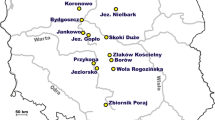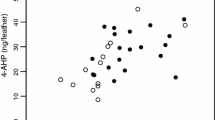Abstract
In many bird species, males display colourful, usually carotenoid or structurally based plumage ornaments. On the other hand, there are many bird species and entire avian genera that are achromatic, i.e. with predominantly white, grey and black plumage colours. Achromatic plumage is a typical feature in many shrikes for example. In this study, we examine the importance of an achromatic plumage pattern, namely, the black tail spots on the two outermost tail feathers (T6 and T5) of Lesser Grey Shrikes (LGS) for sex discrimination and as an indicator of individual quality. Our results suggest that the black tail patterns, especially spots on T5, are important for sex discrimination, but only in combination with other melanin-based or morphological features. The presence of black tail spots on T5 is also an indicator of male age. However, there is no indication that presence, size and asymmetry of these black spots are indicators of individual quality of both sexes in the terms of breeding performances.


Similar content being viewed by others
References
Anderson M (1994) Sexual selection. Princeton University Press, Princeton, New Jersey
Barbosa A, Merino S, Cuervo JJ, de Lope F, Møller AP (2003) Feather damage of long tails in Barn Swallows Hirundo rustica. Ardea 91(1):85–90
Bub M (1981) Stelzen, Pieper und Würger (Kennzeichen und Mauser europäischen Singvögel 2). Neue Brehm Bücherei. A. Ziemsen Verlag, Wittenberg–Lutherstadt
Busse P (1984) Key to sexing and ageing of European Passerines. Beitr zur Naturkunde Niedersachsens 37(Suppl):1–224
Cramp S, Snow D, Perrins CM (1993) The birds of the Western Palearctic, vol 7. Oxford University Press, Oxford, UK
Dohmann M (1980) Geschlechtsdimorphes Schwanzzeichnungsmuster bei Raubwürgern Lanius excubitor ssp. mit verhaltensökologischen und phylogenetischen Anmerkungen. Ökol Vögel 2:151–176
Doucet SM, Mennill DJ, Montgomerie R, Boag PT, Ratcliffe LM (2005) Achromatic plumage reflectance predicts reproductive success in male black-capped chickadees. Behav Ecol 16(1):218–222
Eck S (1973) Intraspezifische Ausformung im Flügel- und Schwanzbau bei Würger-Formenkreisen der Gattung Lanius. Zool Abh Mus Tierk, Dresden 32:75–119
Fitzpatrick S (1998) Colour schemes for birds: structural coloration and signals of quality in feathers. Annales Zoologici Fennici 35(2):67–77
Glutz von Blotzheim U, Bauer K (1993) Handbuch der Vögel Mitteleuropas. Band 13/II. Aula Verlag, Wiesbaden, Germany
Gray DA (1996) Carotenoid and sexual dichromatism in North American passerine birds. Am Nat 148:453–480
Griffith SC (2000) A trade-off between reproduction and a condition-dependent sexually selected ornament in the house sparrow Passer domesticus. Proc R Soc Lond B 267(1448):1115–1119
Hill GE (1988) Age, plumage brightness, territory quality, and reproductive success in the black-headed grosbeak. Condor 90:379–388
Hoi H, Krištín A, Valera F, Hoi C (2004) Clutch enlargement in Lesser Grey Shrikes (Lanius minor) in Slovakia when food is superabundant: a maladaptive response? Auk 121(2):557–564
Iljitshew V (1976) Key to sexing and ageing of Passerines in Soviet Union. Moscow (in Russian)
Keyser AJ, Hill GE (2000) Structurally based plumage coloration is an honest signal of quality in male blue grosbeaks. Behav Ecol 11(2):202–209
Kose M, Mand R, Moller AP (1999) Sexual selection for white tail spots in the barn swallow in relation to habitat choice by feather lice. Anim Behav 58(6):1201–1205
Krištín A, Hoi H, Valera F, Hoi C (1999) Nest site fidelity and breeding biology in the Lesser Grey Shrike (Lanius minor) in Central Slovakia. Ring 21:74
Krištín A, Hoi H, Valera F, Hoi C (2000) Breeding biology and breeding success of the Lesser Grey Shrike (Lanius minor) in a stable and dense population. Ibis 142(2):305–311
Lefranc N, Worfolk T (1997) Shrikes: a guide to the shrikes of the world. Pica Press, New Haven, Connecticut
Mennill DJ, Doucet SM, Montgomerie R, Ratcliffe LM (2003) Achromatic color variation in black-capped chickadees, Poecile atricapilla: black and white signals of sex and rank. Behav Ecol Sociobiol 53:350–357
Møller AP (2000) Symmetry, size and stress. Trends Ecol Evol 15(8):330–331
Møller AP, Thornhill R (1998) Bilateral symmetry and sexual selection: a meta analysis. Am Nat 151:174–192
Panov EN (1983) Die Würger der Palearktis. Die Neue Brehm Bücherei. A. Ziemsen Verlag, Wittenberg Lutherstadt, Germany
Sanz JJ (2001) Latitudinal variation in female local return rate in the philopatric Pied Flycatcher (Ficedula hypoleuca). Auk 118(2):539–543
Schön M (1994) Geschlechts-, Alters- und individuelle Zeichnungsmerkmale des Raubwürgers (Lanius excubitor) im Vergleich mit anderen Würgern: zur Wirksamkeit von Zeichnungsmustern. Ökol Vögel 16:11–80
Siefferman L, Hill GE, Dobson FS (2005) Ornamental plumage coloration and condition are dependent on age in eastern bluebirds Sialia sialis. J Avian Biol 36(5):428–435
Svensson L (1984) Identification guide to European Passerines. Svensson, Stockholm, Sweden
Tomkins JL, Kopiaho JS (2001) Fluctuating asymmetry. In: Encyclopedia of life sciences. Macmillan Nature, London, UK, pp 1–5
Török J, Hegyi G, Garamszegi LZ (2003) Depigmented wing patch size is a condition-dependent indicator of viability in male collared flycatchers. Behav Ecol 14(3):382–388
Valera F, Hoi H, Krištín A (2003) Male shrikes punish unfaithful females. Behav Ecol 14(3):403–408
Votypka J, Simek J, Tryjanowski P (2003) Blood parasites, reproduction and sexual selection in the red-backed shrike (Lanius collurio). Ann Zool Fenn 40(5):431–439
Wirtitsch M, Hoi H, Valera F, Kristin A (2001) Habitat composition and use in the lesser grey shrike (Lanius minor). Folia Zoologica 50(2):137–150
Acknowledgements
We are grateful to P. Tuček, P. Kaňuch, B. Kršiak and the many enthusiastic inhabitants of our study area for field assistance and R. Hengsberger for improving our manuscript. AK and HH were funded from the bilateral exchange programme of the Slovak and Austrian Academy of Science and by a grant of the Slovak Grant Agency no. 2/5152/25, and FV by a grant from the Programa de Becas Postdoctorales de FPI del Ministerio de Educación y Cultura Español. All manipulations with birds comply with the current laws of the country in which they were performed.
Author information
Authors and Affiliations
Corresponding author
Additional information
Communicated by F. Bairlein
Rights and permissions
About this article
Cite this article
Krištín, A., Valera, F., Hoi, C. et al. Do melanin-based tail patterns predict individual quality and sex in Lesser Grey Shrikes Lanius minor?. J Ornithol 148, 1–8 (2007). https://doi.org/10.1007/s10336-006-0091-3
Received:
Revised:
Accepted:
Published:
Issue Date:
DOI: https://doi.org/10.1007/s10336-006-0091-3




